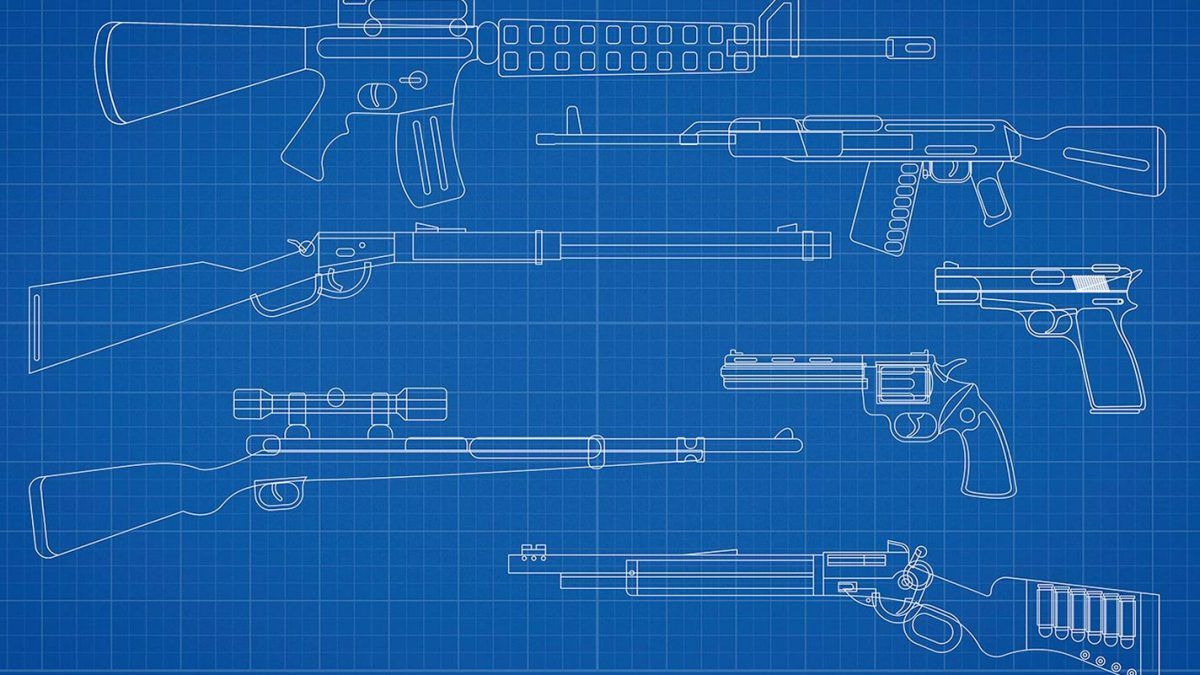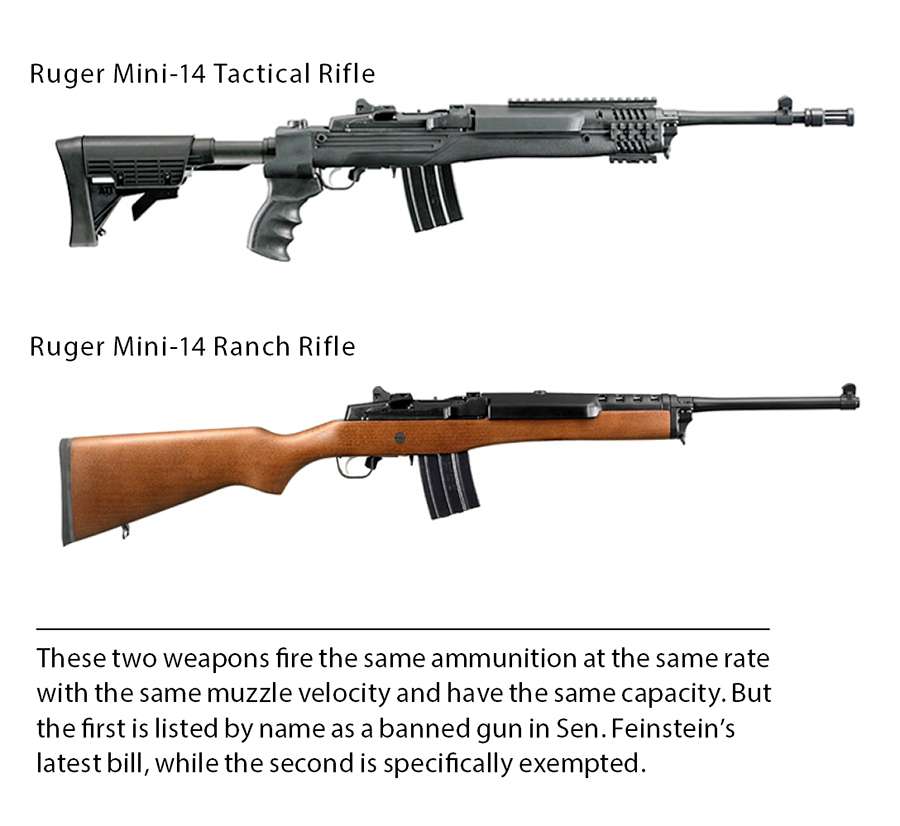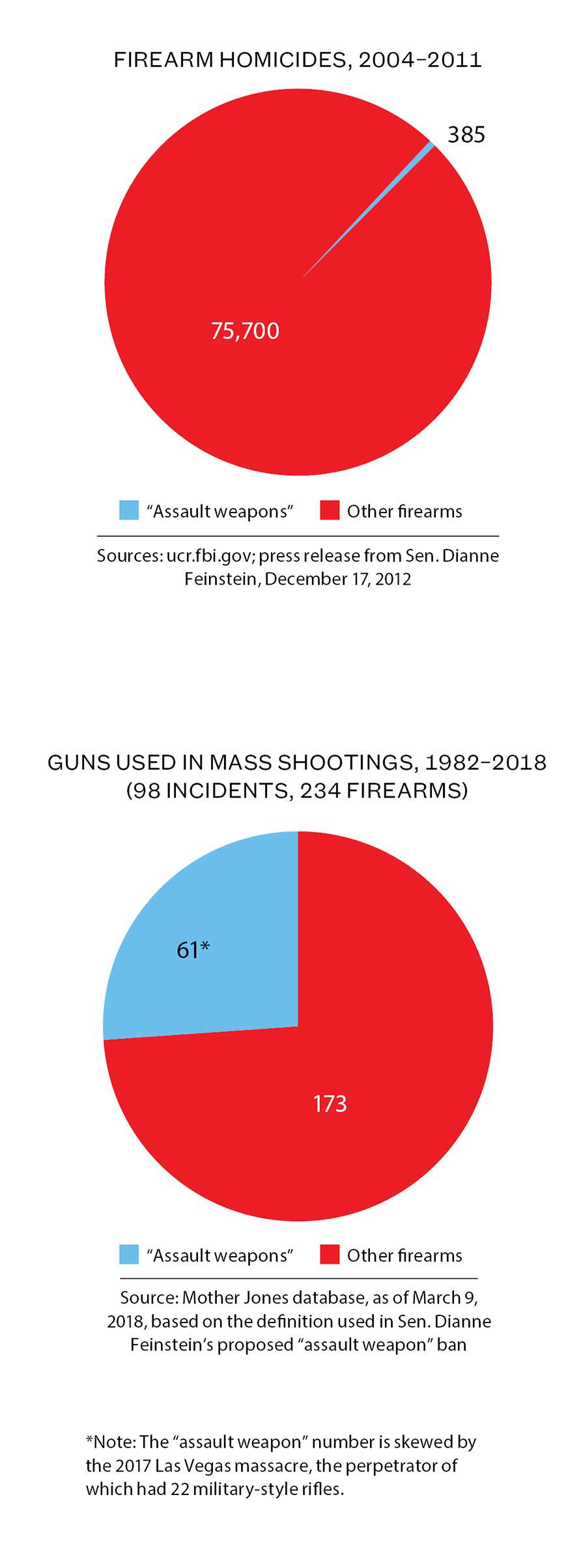'Assault Weapons,' Explained
How a scary name for an arbitrary group of firearms distorts the gun control debate

James Huberty, a 41-year-old survivalist who had recently lost his job as a security guard, spent the morning of July 18, 1984, at the San Diego Zoo with his wife, Etna, and their two daughters. The family ate lunch at a McDonald's restaurant in the Clairemont neighborhood before returning to their home in San Ysidro. After Etna lay down to rest, Huberty approached her and said, "I want to kiss you goodbye." When she asked him where he was going, he said he was "hunting humans."
Just before 4 p.m., Huberty drove his black Mercury Marquis sedan to a San Ysidro McDonald's, where he used three guns—a Browning 9mm pistol, a Winchester 12-gauge shotgun, and an Uzi 9mm semi-automatic carbine—to shoot 40 people. Twenty-one of them died, including an 8-month-old boy and a 9-year-old girl. Seventy-eight minutes after the shooting began, a police sniper killed Huberty with a single shot to the chest.
California Assemblyman Art Agnos, a San Francisco Democrat who would later serve as that city's mayor, cited the San Ysidro massacre as an argument for his 1985 bill banning what he called "assault weapons"—semi-automatic versions of military firearms, such as the Uzi used by Huberty. Unlike the rifles that soldiers carry, which are capable of automatic or burst fire (i.e., holding down the trigger fires either a continuous stream or a short series of rounds), these civilian models fire just one round per trigger pull. But Agnos thought they should be regulated as strictly as machine guns, which ordinary civilians cannot legally possess in California without a permit that is essentially impossible to obtain.
"The only use for assault weapons is to shoot people," Agnos told the Assembly Public Safety Committee in June 1985. San Jose Police Chief Joseph McNamara concurred. "These are weapons of war," he said. "They are made to kill people, and they are all over California. There is no legitimate use for these. Nobody hunts deer with them."
Thus began a long-running public policy fraud that was revived once again after the attack that killed 17 people at Marjory Stoneman Douglas High School in Parkland, Florida, on February 14. "From Aurora to Sandy Hook, San Bernardino to Las Vegas, Sutherland Springs to Parkland, one common thread that runs through mass shootings is the use of AR-15 military-style assault weapons," Sen. Dianne Feinstein (D–Calif.) said a week after the Parkland massacre. "These weapons are designed to kill the greatest number of people in the shortest amount of time, and we need to get these weapons of war off our streets."
"The weapons' menacing looks," one influential activist wrote, "coupled with the public's confusion over fully automatic machine guns versus semi-automatic assault weapons…can only increase the chance of public support for restrictions on these weapons."
Although "assault weapons" fire no faster than any other semi-automatic, such as a Glock 19 pistol or a Ruger 10/22 hunting rifle, politicians routinely conflate them with machine guns, which have not been legally produced for civilians in the United States since 1986. Prohibitionists like Feinstein argue that "assault weapons" are good for nothing but mass shootings and gang warfare, despite the fact that only a tiny percentage of these guns are ever used to commit crimes. They say these firearms are "weapons of choice" for mass shooters, who are in fact much more likely to use handguns, and claim they are uniquely deadly, even though the category is defined based on features that make little or no difference in the hands of a murderer.
Josh Sugarmann, founder and executive director of the Violence Policy Center, laid out this strategy of misdirection and obfuscation in a 1988 report on "Assault Weapons and Accessories in America." Sugarmann observed that "the weapons' menacing looks, coupled with the public's confusion over fully automatic machine guns versus semi-automatic assault weapons—anything that looks like a machine gun is assumed to be a machine gun—can only increase the chance of public support for restrictions on these weapons."
He added that because "few people can envision a practical use for these guns," the public should be more inclined to support a ban on "assault weapons" than a ban on handguns. While handguns are by far the most common kind of firearm used to commit crimes, they are also the most popular choice for self-defense. Proscribing "assault weapons" therefore sounds more reasonable.
This approach has been intermittently effective. In CBS News polls since 1995, public support for banning "assault weapons" has ranged from 44 percent to 70 percent. Quinnipiac University polls since 2013 have consistently found majority support for a nationwide "assault weapon" ban, peaking at 67 percent in a survey conducted a few days after the Parkland shooting. The perpetrator of that attack, Nikolas Cruz, used a Smith & Wesson M&P15 rifle, which is similar to the Colt AR-15, a semi-automatic version of the M16 carried by U.S. soldiers.
Politicians, like voters, tend to see mass shootings as evidence in favor of banning military-style rifles. Although Agnos' bill was rejected by the California Assembly in 1985, the legislature approved a similar ban in 1989. That was the year a 24-year-old drifter named Patrick Purdy used a Norinco Type 56S rifle, a semi-automatic version of a Chinese gun modeled after the AK-47, in an attack that killed five children at a Stockton elementary school. Since then, six other states—Connecticut, Hawaii, Maryland, Massachusetts, New Jersey, and New York—have followed California's example, often enacting or broadening bans after mass shootings. In 1994, Congress passed a federal "assault weapon" ban sponsored by Feinstein.

The federal law, which expired in 2004, banned production and sale of 18 firearm brands or models by name, along with "copies or duplicates" of them. The law also covered guns meeting specified criteria. Any semi-automatic rifle that accepted detachable magazines, for example, was deemed an "assault weapon" if it had two or more of five listed features: a folding or telescoping stock, a pistol grip, a bayonet mount, a grenade launcher, or a "flash suppressor or threaded barrel designed to accommodate a flash suppressor."
There is little evidence that the "assault weapon" ban had an impact on gun deaths. "We cannot clearly credit the ban with any of the nation's recent drop in gun violence," University of Pennsylvania criminologist Christopher Koper and two co-authors wrote in a 2004 report commissioned by the National Institute of Justice. "There has been no discernible reduction in the lethality and injuriousness of gun violence, based on indicators like the percentage of gun crimes resulting in death or the share of gunfire incidents resulting in injury." They concluded that "should it be renewed, the ban's effects on gun violence are likely to be small at best and perhaps too small for reliable measurement."
Casting about for evidence that the law accomplished something, Feinstein cites research by Louis Klarevas, a global affairs lecturer at the University of Massachusetts at Boston. In his 2016 book Rampage Nation, Klarevas attributes a 37 percent drop in mass shooting deaths between 1994 and 2004 to the "assault weapon" ban. But as the journalist Jon Stokes pointed out in the Los Angeles Times last March, the decline cited by Klarevas involves crimes that were committed mostly with weapons unaffected by the ban. Furthermore, the decrease disappears if you use the most widely accepted definition of a mass shooting, which requires four or more deaths, rather than Klarevas' cutoff of six. In other words, the drop is apparent only if you ignore mass shootings with four or five deaths.
It is hardly surprising that Feinstein's ban does not seem to have had a significant impact on public safety. To begin with, the targeted firearms were used in only 2 percent or so of gun crimes before the law passed, according to most studies. Feinstein claimed guns covered by the revised ban she introduced in 2013 were involved in "at least" 385 murders from 2004 through 2011, a period when the FBI counted more than 76,000 gun homicides. That means "assault weapons" were used in something like 0.5 percent of gun homicides during that period.

According to the FBI, rifles of all kinds (not just the ones Feinstein wants to ban) accounted for just 3 percent of firearm homicides in 2016, while handguns accounted for 65 percent. The rest of the firearms were listed as shotguns (2.4 percent), "other guns" (1.7 percent), and unspecified (28 percent).
Contrary to the impression left by press coverage highlighting scary-looking rifles, handguns are also the most common choice for mass shooters. A Mother Jones review of mass shootings from 1982 through 2012 found that 66 percent of the weapons were handguns, while just 14 percent would qualify as "assault weapons" under the definition used in Feinstein's 2013 bill.
As of mid-March, according to the updated Mother Jones database, the share of mass shooters' weapons covered by Feinstein's bill had risen to 26 percent. But that change was mostly due to the 22 military-style rifles that police found in the hotel suite and adjacent room from which Stephen Paddock fired on a crowd of country music fans in Las Vegas last October. No other modern mass shooting has involved anywhere near that many guns, and police have not said how many of them Paddock actually fired. Excluding that outlier, "assault weapons" accounted for 19 percent of firearms used in mass shootings, which in turn represent a tiny share of gun homicides—0.6 percent in 2016.
No one could have reasonably expected that the 1994 ban would eliminate even the small subset of gun crimes committed with the weapons it covered, since the law exempted firearms people already owned. By Koper's estimate, that grandfather clause left more than 1.5 million "assault weapons" in circulation.
After the law expired, sales of previously banned rifles exploded. Based on production and import data from 1990 through 2016, the National Shooting Sports Foundation, a trade group, estimates that Americans own more than 16 million guns that politicians would deem "assault weapons," which the industry prefers to call "modern sporting rifles." Feinstein's proposed ban, like the 1994 law, would not apply to those firearms. If grandfathered guns undermined the original ban, that problem is more than 10 times as big today.
Even if the 1994 ban had made all of the targeted guns disappear, there would have been plenty of equally lethal alternatives available to mass murderers or gang members. Gun control advocates frequently complained that firearm manufacturers got around the law by making minor, functionally unimportant changes to their products. Bushmaster, for instance, introduced the XM-15 rifle, a ban-compliant version of the AR-15. The Coalition to Stop Gun Violence notes that it was "functionally equivalent in all relevant respects to its banned cousin." But if companies could legally produce guns that were just as deadly as the ones covered by the ban, that was an indictment of the law, not the manufacturers who complied with it.
The supposedly improved ban that Feinstein is pushing now casts a wider net but suffers from the same basic flaw: It defines the prohibited guns based on features with little or no functional significance in the context of mass shootings or other violent crimes. The bill covers "157 dangerous military-style assault weapons" by name (up from 18) and defines the targeted firearms more broadly. Semi-automatic rifles that accept detachable magazines qualify if they have one or more (rather than two) of six (up from five) specified characteristics.
The forbidden features are somewhat different but still pretty puzzling. Feinstein no longer thinks we need to worry about bayonet mounts, but she is now sounding the alarm about the ominous barrel shroud, a covering that protects the shooter's hand from the heat generated by firing a rifle. She also has added rocket launchers to the equally fanciful grenade launchers as prohibited accessories. Crimes committed with rifle-mounted grenade or rocket launchers are about as common in the United States as crimes committed with rifle-mounted bayonets. Even if someone decided to attach a grenade or rocket launcher to his rifle, he would have a hard time finding something to launch with it, since both grenades and rockets are strictly regulated as "destructive devices" under the National Firearms Act.
"Defining an assault weapon—in legal terms—is not easy," Josh Sugarmann warned back in 1988. "It's not merely a matter of going after guns that are 'black and wicked looking.'" Yet that is basically what Feinstein and likeminded state legislators have done. To give you a sense of how arbitrary Feinstein's distinctions are, her bill specifically exempts the Iver Johnson M1 carbine and the Ruger Mini-14 rifle, but only when they have fixed stocks. Adding a folding or adjustable stock to these rifles transforms them from legitimate firearms into proscribed "assault weapons," even though that change does not make them any more lethal or suitable for mass murder. A folding stock makes a rifle shorter for transport or storage, while an adjustable stock allows a more comfortable fit for shooters of different sizes.
Many supporters of "assault weapon" bans seem confused about what they entail. In a widely mocked 2007 interview on MSNBC, Rep. Carolyn McCarthy (D–N.Y.), who had introduced a bill that would have banned semi-automatic rifles with barrel shrouds, confessed, "I actually don't know what a barrel shroud is. I'm assuming it's a shoulder thing that goes up." Politicians such as Barack Obama and Hillary Clinton often say "machine guns" or "automatic weapons" when they are talking about semi-automatic rifles. According to a Reason-Rupe survey conducted around the time that Feinstein introduced her 2013 bill, about two-thirds of Americans mistakenly thought "assault weapons" fire faster than other guns, hold more rounds, or use higher-caliber ammunition. The respondents who harbored these misconceptions were especially likely to say such guns should be banned.
Rep. Carolyn McCarthy, who had introduced a bill that would have banned semi-automatic rifles with barrel shrouds, confessed, "I actually don't know what a barrel shroud is. I'm assuming it's a shoulder thing that goes up."
People who know better may nevertheless support "assault weapon" bans as a tactic for achieving more stringent gun restrictions down the road. "No one should have any illusions about what was accomplished," The Washington Post editorialized after President Bill Clinton signed the 1994 ban into law. "Assault weapons play a part in only a small percentage of crime. The provision is mainly symbolic; its virtue will be if it turns out to be, as hoped, a stepping stone to broader gun control."
The faulty logic of such legislation actually works to the benefit of those who support "broader gun control." Once people realize that banning these firearms has no measurable effect on violence, they may be primed to accept more ambitious measures. At the same time, if the flimsy arguments in favor of "assault weapon" bans are enough for them to survive judicial review, the Second Amendment barriers to gun control will be eroded.
Federal appeals courts rejected constitutional challenges to the 1994 law, but that was before the Supreme Court ruled, in the 2008 case District of Columbia v. Heller, that the Second Amendment protects an individual right to own guns for self-defense in the home. In 2015, the Supreme Court declined to review a decision in which the U.S. Court of Appeals for the 7th Circuit upheld a ban on "assault weapons" imposed by Highland Park, Illinois. Justice Clarence Thomas vigorously objected, noting that the ban covered "many of the most commonly owned semiautomatic firearms." The Supreme Court's overturning of the D.C. handgun ban in 2008, Thomas said, made it clear that the Second Amendment encompasses firearms "commonly used for a lawful purpose." Yet the 7th Circuit had upheld Highland Park's ban based on nothing more than "speculation about the law's potential policy benefits," including the possibility that it "may increase the public's sense of safety."
That highly deferential approach should alarm anyone who values the constitutional right to armed self-defense. "If a broad ban on firearms can be upheld based on conjecture that the public might feel safer (while being no safer at all)," Thomas wrote, "then the Second Amendment guarantees nothing."
This article originally appeared in print under the headline "'Assault Weapons,' Explained."




Show Comments (436)